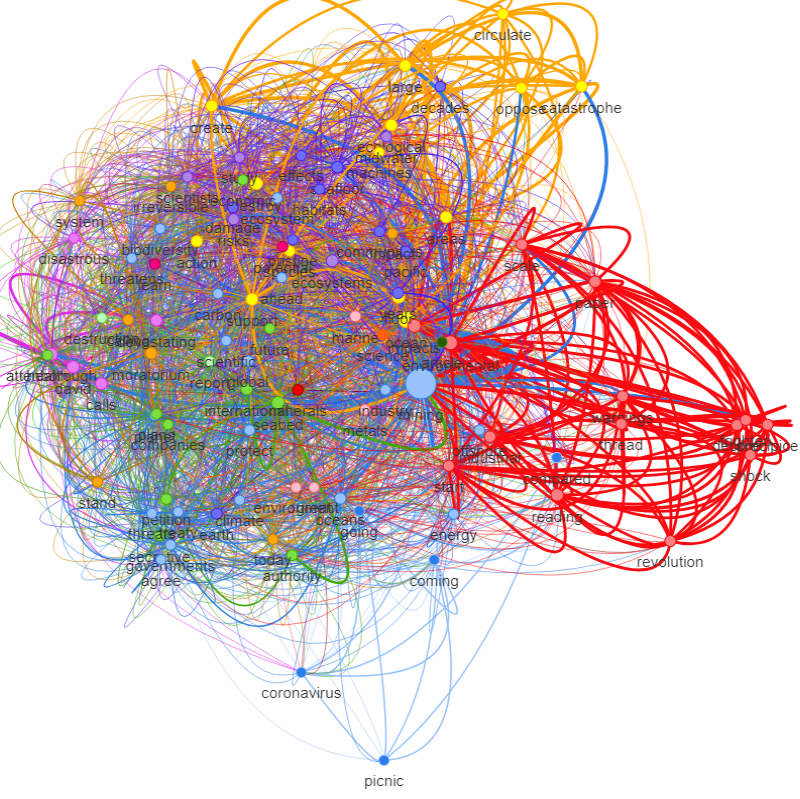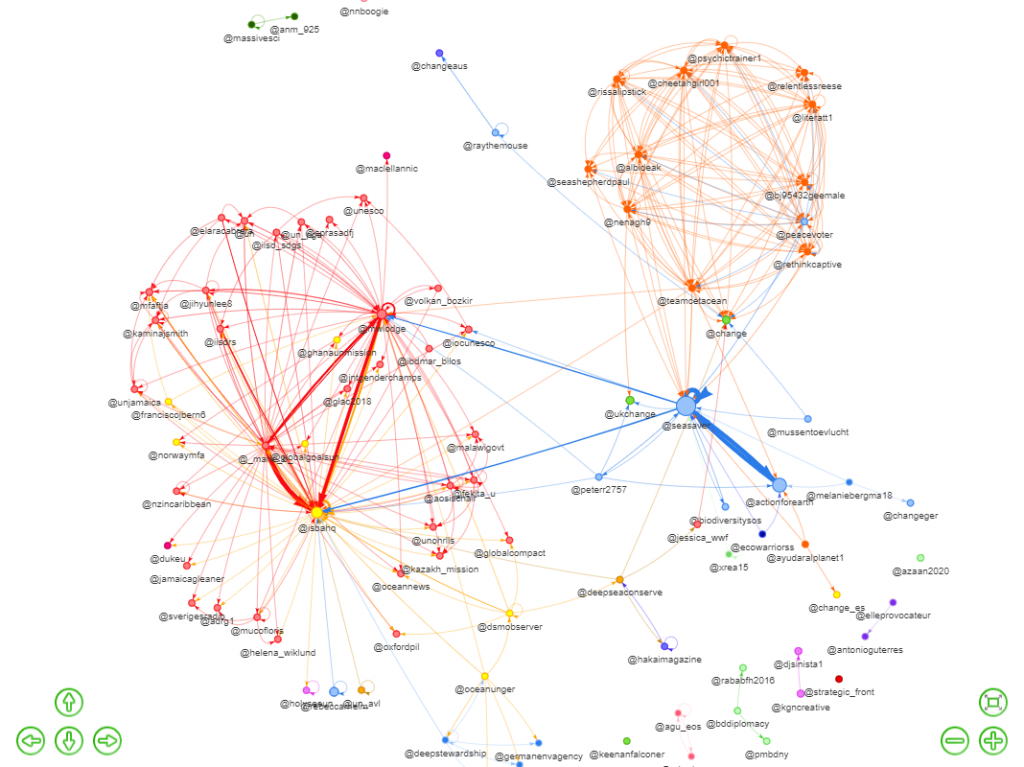Almost 1 year ago, just before the commencement of the 26th Session of the International Seabed Authority in February, we began analytically tracking the online conversation surrounding deep-sea mining. Using a service called SocioViz, DSM Observer implemented a year-long sentiment and network analysis Big Listening campaign across a range of keywords used by stakeholders to discuss deep-sea mining on Twitter (the only major social media platform which provides easily accessible high resolution user data through the Twitter API). We assessed two sets of keyword groups: a general set revolving broadly around the concept of deep-sea mining and a specific set related to discussions surrounding the International Seabed Authority.
By examining the structure of online social networks and analyzing connections among stakeholders, contractors, member states, NGOs, and governmental agencies, we can better assess how stakeholders and the general public discuss and understand the industry.
You can read our first two assessments, one immediately following the Part I of the 26th Session and one at the six month mark, here:
- What do people talk about when they talk about Deep-sea Mining?
- What people talk about when they talked about deep-sea mining this summer
Deep-sea mining was mentioned over 25,000 times on Twitter over the last year, with more than 14,000 individuals contributing to the online conversation. The most common words used were predominantly descriptive (mining, ocean, seabed, reading, floor) though the sentiment trended negative with words like “environmental”, “impact”, “destroy”, and, unsurprisingly, “David” and “Attenborough”. Hashtag use also trended towards environmental or purely negative sentiments. The only neutral hashtags were #deepseamining, #deepsea, #ocean, and #mining, while #defendthedeep, #stopdeepseamining, #deeptrouble, #protecttheoceans, #oneoceanoneplanet, and #keepitintheseabed were prevalent.

Analysis of word clusters showed three non-overlapping conversations occurring across Twitter. A large central cluster accounted for the vast majority of general discussion without any clear trends in sentiment, but two separate “catastrophist” nodes branched off of the central cluster, suggesting that those who view the industry the most negatively were not directly engaged in the larger conversation surrounding deep-sea mining. Network analysis of the 100 most influential individuals discussing deep-sea mining showed similar results. Communications and outreach professionals can efficiently capture the vast majority of the Twitter-based deep-sea mining conversation by following @deepseaconserve, @duncan_currie, @isbahq, @divaamon, @deepstewardship, @seasaver, and @rebeccarhelm, as well as @dsmobserver and @drandrewthaler.
The International Seabed Authority was mentioned a little less than 5,000 times over the last year, with slightly more than 2,500 individuals contributing to the online conversation. The most common words used were almost entirely descriptive (mining, seabed, international, authority, ocean, areas, floor, ecological, and large) with only one clearly negative sentiment: “catastrophe”. While the most commonly used hashtag was #stopdeepseamining, whose prominence is related to an online petition campaign directed at the Authority. The remaining frequent hashtags are purely descriptive (#isba26, #isabahq, #kingston, #deepsea, #deepseamining, #sdg14, #jamaica, #unclos, #mining).
Cluster analysis of the 100 most commonly used words in tweets about the International Seabed Authority breaks out into four large groups, including one related to procedural discussions about meetings and agendas, one focused around broader principles and UN sustainable development goals, one about science and exploration, and a fine node which sits slightly away from the main clusters that captures more catastrophist discussions surrounding seabed mining, with very little overlap between the catastrophist cluster and the other three nodes.

Network analysis of the 100 most influential individuals discussing the International Seabed Authority is even more pronounced, with two discrete clusters with no overlap save for a predominantly news curation account. Communications and outreach professionals can efficiently capture the vast majority of the Twitter-based International Seabed Authority conversation by following just five accounts: @mwlodge, @isbahq, @_marie_b_, @seasaver, and @teamcetacean.
As always, we try to provide this analysis as a values-agnostic look at how people talk about deep-sea mining online. As in past assessments, the sentiment of the conversation trends negatively towards the industry, with much more coordination among the environmental NGOs and anti-mining activist groups and almost no involvement from the principal contractors. Unlike this summer, where a strong negative spike was created by a handful of newsworthy events, the overall online sentiment is much more generally, likely heighted by a series of workshops held late in the year which prompted more detailed discussion of the process. The lack of a summer ISA session left a vacuum in the larger conversation where scientific and policy experts would be usually engaged in information sharing during the course of discussion.
While generic public outreach is not always the best tactic to use for a developing industry, there remains a vast opportunity for deep-sea mining contractors to present their case to the public at large. As it currently stands, those entities most supportive of deep-sea mining have practically no presence in the online conversation.